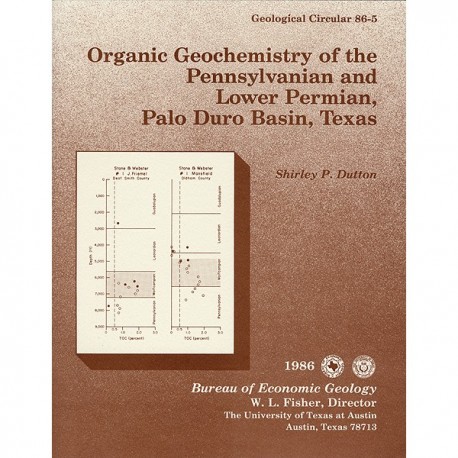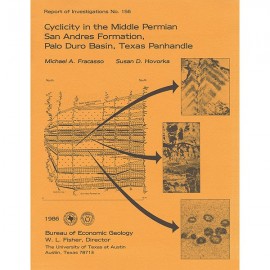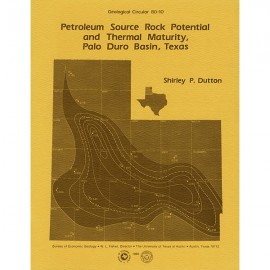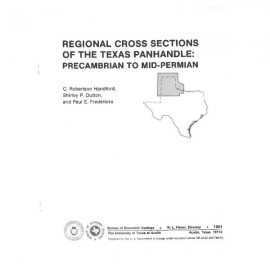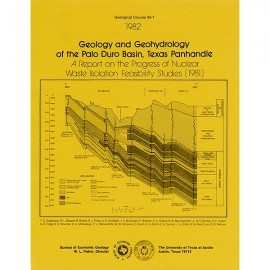Geological Circulars
-
Books & Reports
- Reports of Investigations
- Guidebooks
- Udden Series
- Geological Circulars
- Down To Earth
- Atlases of Major Oil and Gas Reservoirs
- Texas Memorial Museum Publications
- Environmental Geologic Atlas of the Texas Coastal Zone
- Mineral Resource Circulars
- Other Reports
- Seminars and Workshops
- Handbooks
- Submerged Lands of Texas
- Symposia
- Annual Reports
- Open File Reports
-
Maps & Cross Sections
- Thematic Maps
- Miscellaneous Maps, Charts & Sections
- Geologic Atlas of Texas
- STATEMAP Project Maps
- Geologic Quadrangle Maps
- Cross Sections
- Highway Geology Map
- Energy and Mineral Resource Maps
- Shoreline Change and Other Posters
- Wilcox Group, East Texas, Geological / Hydrological Folios
- Bouguer Gravity Atlas of Texas
- River Basin Regional Studies
- Featured Maps
- Posters
- Teachers & the Public
-
Geological Society Publications
- Gulf Coast Association of Geological Societies
- Alabama Geological Society
- Austin Geological Society
- Corpus Christi Geological Society
- Houston Geological Society
- Lafayette Geological Society
- Mississippi Geological Society
- New Orleans Geological Society
- South Texas Geological Society
- GCS SEPM Publications
- Historic BEG & UT Series
Organic Geochemistry of the Pennsylvanian and Lower Permian Palo Duro Basin, Texas
GC8605
For a downloadable, digital version: GC8605D.
GC8605. Organic Geochemistry of the Pennsylvanian and Lower Permian Palo Duro Basin, Texas, by S. P. Dutton. 28 p., 13 figs., 3 tables, 2 appendices, 1986. ISSN: 00823309. Print.
To purchase this publication as a PDF download, please order GC8605D.
ABSTRACT
Cores from deep stratigraphic test wells provide an excellent basis for determination of source-rock quality and thermal maturity of potential hydrocarbon source rocks in the Palo Duro Basin. Total organic carbon (TOC) content in Pennsylvanian and Wolfcampian rocks is highest in basinal shales. TOC values greater than 0.5 percent are common, which indicates that Palo Duro Basin shales contain sufficient organic matter to serve as source beds. Microscopic identification indicates that vitrinite, herbaceous material, and amorphous organic matter are the most abundant types of kerogen. Pyrolysis data show that the shales contain primarily Type III organic matter (vitrinite); these data provide evidence that the amorphous organic matter is composed predominantly of degraded vitrinite as opposed to algal or herbaceous material.
Thermal maturity was estimated by kerogen color, vitrinite reflectance, and pyrolysis. Yellow kerogen is considered immature, yellow-orange kerogen marginally mature, and orange kerogen mature. Pennsylvanian shales contain kerogen that is yellow orange to orange, but Wolfcampian kerogen is lighter in color, generally yellow to yellow orange. Vitrinite reflectance (RO) was measured by three independent laboratories. The labs reported significantly different values of (RO) even on identical samples, but because they use different RO levels as maturity standards, the labs gave similar maturity assessments. According to the lab that performed analyses on all of the samples, an RO of 0.5 occurs at 5,200 ft (1,600 m) in the Palo Duro Basin; Type I and Type II kerogen should be mature at this depth. Maturation of Type III kerogen corresponds to an RO value of 0.75 percent, which is projected to occur well below the depth of crystalline basement in most of the Palo Duro Basin. Pyrolysis indicates that Pennsylvanian and Wolfcampian shales from a well in Oldham County and Pennsylvanian shales from a well in Swisher County are thermally mature.
The three methods of assessing thermal maturity—kerogen color, vitrinite reflectance, and pyrolysis—indicate that Pennsylvanian and lower Wolfcampian shales in the Palo Duro Basin have probably reached temperatures high enough for the onset of oil generation in Type I and Type II organic matter. However, much of the organic matter in the Palo Duro Basin is Type III, and temperatures have not been high enough to generate oil or gas from it.
Keywords: hydrocarbon potential, organic geochemistry, Palo Duro Basin, source rocks, thermal maturity
Citation
Dutton, S. P., 1986, Organic Geochemistry of the Pennsylvanian and Lower Permian Palo Duro Basin, Texas: The University of Texas at Austin, Bureau of Economic Geology Geological Circular 86-5, 28 p.
